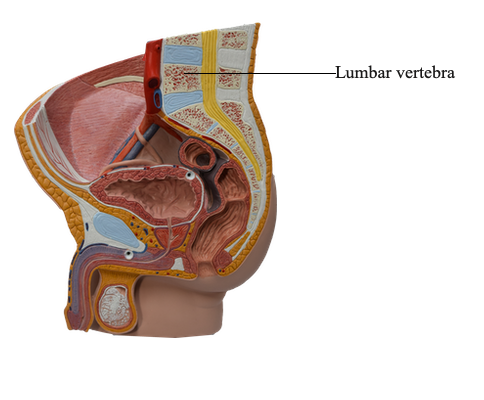Main Model

Lumbar vertebra

Lumbar Vertebrae
Lumbar vertebrae are in the lower back between the thorax and sacrum. Because the weight they support increases toward the inferior end of the vertebral column, lumbar vertebrae have massive bodies, accounting for much of the thickness of the lower trunk in the median plane. Their articular processes extend vertically, with articular facets sagittally oriented initially (beginning abruptly with the T12-L1 joints), but becoming more coronally oriented as the column descends.
The L5-S1 facets are distinctly coronal in orientation. In the more sagittally oriented superior joints, the laterally facing facets of the inferior articular processes of the vertebra above are “gripped” by the medially facing facets of the superior processes of the vertebra below, in a manner that facilitates flexion and extension and allows lateral flexion, but prohibits rotation.
The transverse processes project somewhat posterosuperiorly as well as laterally. On the posterior surface of the base of each transverse process is a small accessory process, which provides an attachment for the intertransversarii muscles. On the posterior surface of the superior articular processes are small tubercles, the mammillary processes, which give attachment to both the multifidus and intertransversarii muscles of the back.
Vertebra L5, distinguished by its massive body and transverse processes, is the largest of all movable vertebrae. It carries the weight of the whole upper body. The L5 body is markedly taller anteriorly; therefore, it is largely responsible for the lumbosacral angle between the long axis of the lumbar region of the vertebral column and that of the sacrum. Body weight is transmitted from L5 vertebra to the base of the sacrum, formed by the superior surface of S1 vertebra.
Characteristic Features of Lumbar Vertebrae
• Vertebral body: Massive; kidney shaped when viewed superiorly
• Vertebral foramen: Triangular; larger than in thoracic vertebrae and smaller than in cervical vertebrae
• Transverse processes: Long and slender; accessory process on posterior surface of base of each process
• Articular processes: Nearly vertical facets; superior facets directed posteromedially (or medially); inferior facets directed anterolaterally (or laterally); mammillary process on posterior surface of each superior articular process
• Spinous processes: Short and sturdy; thick, broad, and hatchet shaped